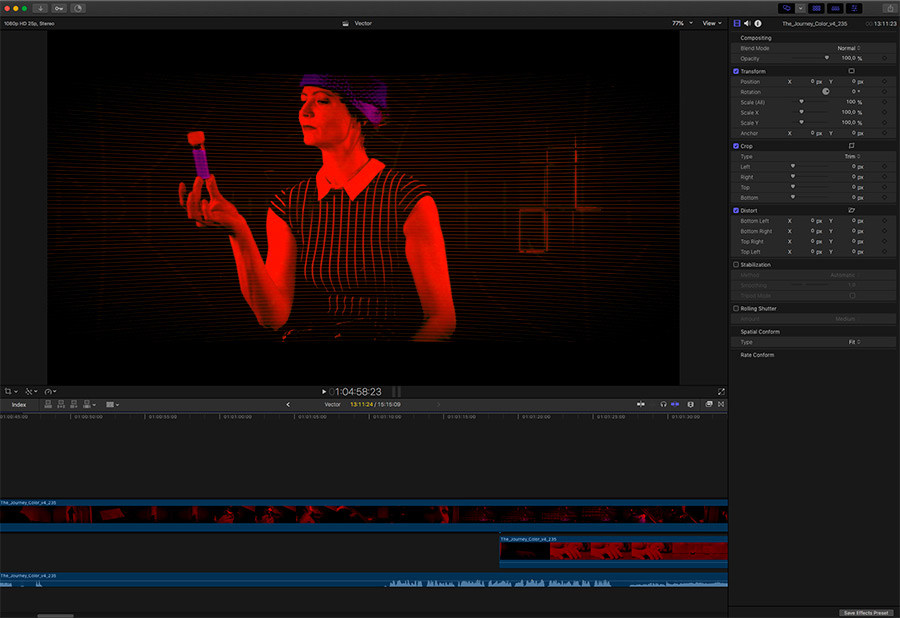DISCLOSURE: AS AN AMAZON ASSOCIATE I EARN FROM QUALIFYING PURCHASES. READ THE FULL DISCLOSURE FOR MORE INFO. ALL AFFILIATE LINKS ARE MARKED #ad
Key Takeaways
- Final Cut Pro offers an intuitive interface and fast performance on Mac.
- Premiere Pro excels in color grading and customization and is suited for serious filmmaking and greater collaboration.
- Both programs cater to different user needs: Final Cut is for ease and efficiency, and Premiere is for depth and control.
- Pricing models vary significantly, with Final Cut Pro’s one-time fee and Premiere Pro’s monthly subscription impacting long-term costs.
The Apple Final Cut Pro vs. Adobe Premiere Pro contest is a tough one to call. They dominate the high-end section of the market, overshadowing all other heavyweights. You can hardly go wrong with either one if you seek to cover professional video editing needs.
At the same time, their nuts and bolts differ in some important ways. This can make a big impact on your editing experience and shape the success of the projects. So, take a deep breath and get ready to swallow some hard facts.
Let’s check out how the two tools compare in several key categories.
Table of Contents
User-Friendliness for Beginners

Final Cut Pro comes out of the gate strong. It has an incredibly intuitive interface that first-time users tend to find welcoming. Everything is where it should be and fits the editing workflow seamlessly. You spend minimum time trying to locate the desired feature.
Compared to that, Adobe Premiere Pro feels less accessible. It’s tailored to seasoned editors, not newcomers. We would say this isn’t a bad thing per se.
What it sacrifices on being beginner-friendly, it gains on other fronts. Finding files is a breeze, and layers are separated. It’s a joyride from there once you get the hang of all the menus.
The takeaway to draw is clear. Apple’s flagship takes it in the first round. It’s an advanced tool that doesn’t face you with a steep learning curve.
Performance and Optimization

Final Cut Pro runs lightning-fast without skipping a beat. It’s perfectly geared for peak performance on Mac devices. All videos, including those in 4 K quality, can expect short exporting and rendering times. The beauty is that your device will also consume little power while doing that.
Adobe Premiere is considerably slower because it wasn’t designed for one platform. It harnesses whatever resources it can to deliver functionalities, and this lack of bespoke quality shows when rendering and editing videos.
That said, Adobe has now made it possible to use the GPU on your graphics card. So, if you own an NVIDIA graphics card, you can now see up to five times faster rendering times in Premiere Pro.
So, provided you have a Mac computer or don’t own a good NVIDIA graphics card, Final Cut Pro wins in terms of performance. Otherwise, you may want to choose Premiere Pro.
Workflow: Timeline and Tracks

Final Cut Pro’s timeline isn’t for everyone. Many people are instantly put off or feel restricted by it. Others love it—go figure. The truth is it works much like a storyline for gluing scenes together.
There is a neat feature that does away with anything that could interfere with the workflow. The Connected Clips option feature enables you to cycle through different pieces of material.
Adobe Premiere’s timeline is a more traditional approach to nonlinear editing. It offers the utmost flexibility and precision when handling individual elements (layers). There are tracks and track heads; your content is displayed as a sequence. Organizational tools and tabs for different sequences are a treat. The overall customization and control level is greater, making collaboration easier.
All in all, we prefer Premiere Pro when discussing strictly the timeline and bigger projects. It offers a wide range of editing features. Final Cut Pro does the trick when working alone or in a small team.
A Matter of Color Options

Adobe Premiere Pro is superior when it comes to color grading. The spectrum of manipulation options is vast and varied. You can easily convey emotions, create eye-popping effects, and make your raw videos come alive.
Lumetri Color tools also support 3D LUTs, which is nice if you want to test some looks quickly.
Final Cut Pro isn’t that far behind, though. Recent versions of Color Wheels have narrowed the gap that used to be quite wide. You can also add external plugins to expand the range of possibilities (this is also possible in Premiere Pro).
Final Cut is more suited for simple videos than serious filmmaking and long-format editing for big screens. The latter honor goes to Adobe Premiere.
Exporting, Importing, and Rendering

Adobe Premiere offers a wide array of export presets. They support small smartphone screens, big cinema projectors, and everything in between, so you can thoroughly optimize your videos for the target audience. The drawback is everything takes a bit more time and is less intuitive.
Apple’s Final Cut has some good import functions. For instance, you can look at your snippets/files before uploading them. This quality-of-life feature allows you to avoid unnecessary bulk importing.
That being said, Final Cut has some weird stuff going on. For example, suppose your project doesn’t conform to some very limited aspect ratios. In that case, your color space will look weird, and you will have to dive into the submenus and override the color space for everything to appear normal.
Also, you cannot export Final Cut projects in Advanced Authoring Format (AAF) format, which is a really big deal if you want to quickly send your projects to someone else who uses another program, e.g., a sound guy who mixes in ProTools or a project transfer from Premiere Pro to Avid or vice versa.
Adobe Premiere Pro has a really powerful way of creating proxies when importing, i.e., converting processor-heavy files like 4K, 6K, and 8K resolution video to a lower-quality file for editing.
This is to say that Premiere Pro is far superior in importing and exporting footage.
The Price Difference
The price tag is seldom the main selling point, but it’s worth mentioning. After all, the two tools involve different pricing schemes.
For Final Cut Pro (complete package), you must bid farewell to $299. And it’s a one-time payment. Later, you can add plugins as you see fit.
On the other hand, Premiere Pro is a subscription-based service, part of the Adobe Creative Cloud. A monthly subscription separates you from $19.99 to $239.88 annually. We recommend getting the Adobe Creative Suite, which includes Premiere Pro, After Effects, Photoshop, Illustrator, and more, as it offers so much more value for the money.
As you can see, Final Cut Pro is far less pricey. It costs a bit more than Premiere Pro’s yearly subscription, but you pay for it once and are done with it. Just the way it should be.
Apple Final Cut Pro vs. Adobe Premiere: The Verdict
The Apple Final Cut Pro vs. Adobe Premiere contest has no undisputed winner. They are both remarkable choices for top-notch movie and TV production.
Nevertheless, the side-by-side comparison reveals their strengths and weaknesses. This means they fit different needs and use cases. Consider the type of projects you’re working on and your audience.

